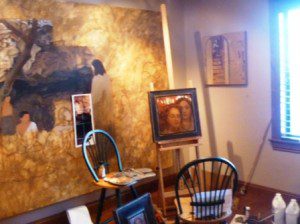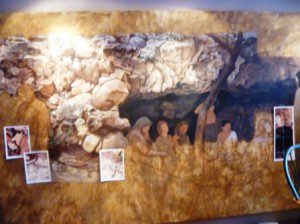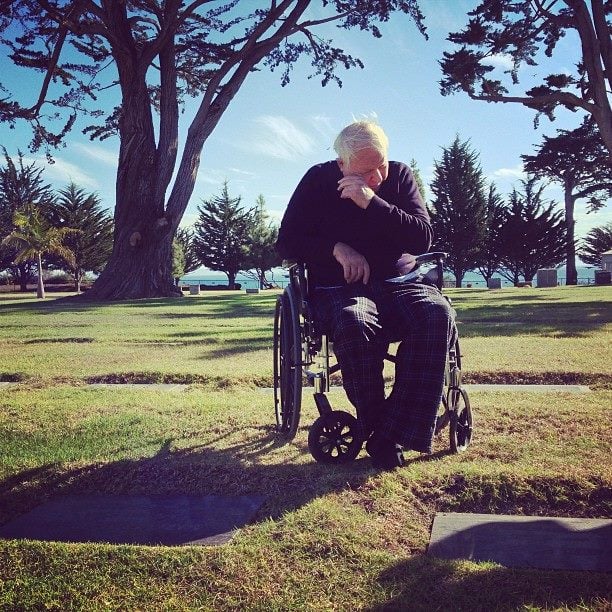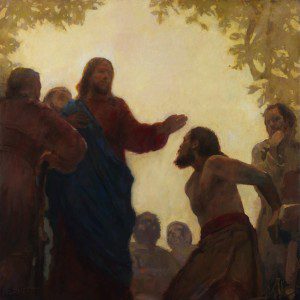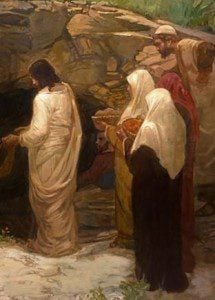Part I: Caves
A year ago, I visited J. Kirk Richards’s studio. I saw a large, mid-creation painting. A few of his students had worked on the piece, filling in the details. It was clear that this work represented a community in an enclosed area, but I couldn’t guess who they were. The suggestion of Christ outside the cave was just a suggestion. What was the Savior doing? In the early rendition, there were no women behind Jesus, but there are three in the final draft. Who are they? Why are they with Him, carrying baskets of food?
Those in the cave were outlined, and pictures posted to inspire the final versions. Who were these people? What kind of a community was this? Some were outside of the cave, and yet seemed to be a part of that dark society. Were they guards? Were they undecided on where they belonged–in the light or in the darkness?
Kirk told me that this painting would portray Christ with the lepers.
How interesting. I had not pictured Christ approaching a cave. When I read of the lepers, I had imagined them coming to Him (Luke 17). I imagined him turning to them as they proclaimed themselves “unclean” and laying his hands on their heads. And only one returned to thank him–and that one, the scriptures mention, was a Samaritan–not only a leper but from a dishonored group.
11 And it came to pass, as he went to Jerusalem, that he passed through the midst of Samaria and Galilee.
12 And as he entered into a certain village, there met him ten men that were lepers, which stood afar off:
13 And they lifted up their voices, and said, Jesus, Master, have mercy on us.
14 And when he saw them, he said unto them, Go shew yourselves unto the priests. And it came to pass, that, as they went, they were cleansed.
15 And one of them, when he saw that he was healed, turned back, and with a loud voice glorified God,
16 And fell down on his face at his feet, giving him thanks: and he was a Samaritan.
17 And Jesus answering said, Were there not ten cleansed? but where are the nine?
18 There are not found that returned to give glory to God, save this stranger.
19 And he said unto him, Arise, go thy way: thy faith hath made thee whole.
I like what Kirk has done. Christ goes THERE. He knows who they are and where they are. Yes, they are “afar off.” And they ask for “mercy.” What do they mean by this? Comfort? Money? Do they have any idea of what Jesus can give them?
Do they want to be healed? In the cave, they have a community. They have their disease in common. They likely have their own vocabulary. What would it mean to leave that community and venture into a world they have approached only as beggars, outsiders? Those nine who did not return to the healer, did they find themselves squinting in unbearable light and seeking the comfort of the cave? Did they learn that others continued to see leprous skin or to fear that it was all a trick and they were yet unclean, could yet infect others? Did they imagine themselves still leprous? Did they examine their skin with skeptical eyes, translating a mole as the returned disease? What does gratitude mean for a leper?
I love the finished painting–which I can fit only in low resolution on this post. The Lord is clearly touching a leper’s hand. Is he helping him into the light? That particular gesture was obscured by my first view of the in-progress painting. Jesus would have had no fear, but what of the leper? Would he imagine himself so toxic, would his training have been so complete that he would wait a long moment before extending his leprous hand to this clean one?
Oh, we’ve seen it, haven’t we? The young woman who considers herself “unworthy” because of any number of things. She sees a distortion in her mirror and cannot conceive of the possibility that anyone would find her attractive. She eats as punishment, and vomits as a release and a reminder of how putrid she is, inside and out. Unclean. Or the young man who worries that everyone knows his secrets and condemns him. That he should not touch the sacrament bread or even say a prayer beyond “Bless us to be good.” Who looks at his parents and imagines how ashamed they would be if they knew everything about him (not realizing that his parents had similar thoughts in their youth). Or the teenager who messed up and got arrested, and sometimes looks at that picture of himself on Criminal Records–hair disheveled, eyes half awake, mouth a grimace. “Yes, that is me. I’m a mess.”
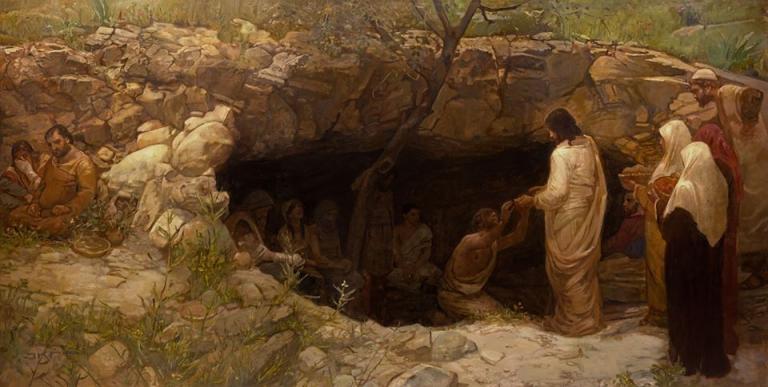
In addiction recovery, whether LDS ARP or AA, step 6 is this: Become entirely ready to have God remove all your character weaknesses.
We are made clean through Him. Denying His grace in order to punish ourselves lessens our power and His. If we will not allow ourselves to be redeemed, our choice will be honored.
What a frightening journey that can be, away from the cave. No more obsessive conversations about our wounds or the ways our loved ones have betrayed us. Or how we have betrayed ourselves. No more fear of being fully seen by one who is not diseased. Accepting healing means accepting a new life.
How appropriate that Christ’s tomb was a cave. The stone was rolled back to let light in, and to let The Light out. And when Mary did not recognize the man she knew to be dead, he simply said her name.
I wonder if Jesus is saying the name of the one whose hand he holds in Kirk’s painting. I think he might be. And perhaps, “Come and see.”


